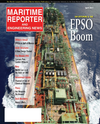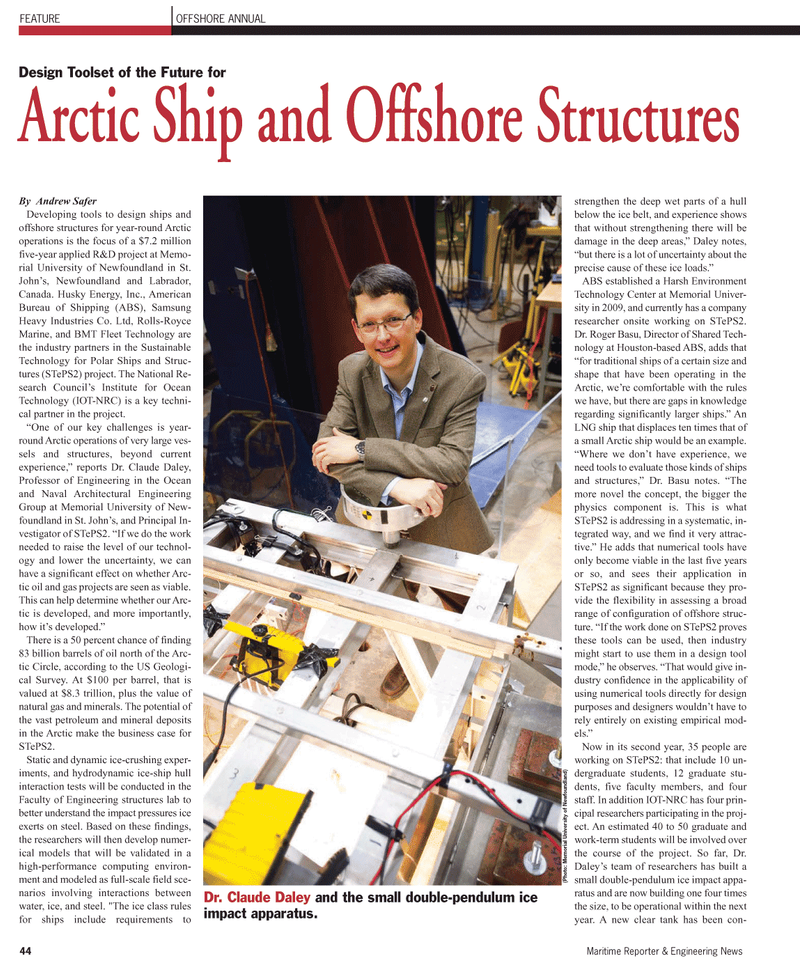
Page 44: of Maritime Reporter Magazine (April 2011)
Offshore Annual
Read this page in Pdf, Flash or Html5 edition of April 2011 Maritime Reporter Magazine
FEATURE OFFSHORE ANNUAL
By Andrew Safer
Developing tools to design ships and offshore structures for year-round Arctic operations is the focus of a $7.2 million five-year applied R&D project at Memo- rial University of Newfoundland in St.
John’s, Newfoundland and Labrador,
Canada. Husky Energy, Inc., American
Bureau of Shipping (ABS), Samsung
Heavy Industries Co. Ltd, Rolls-Royce
Marine, and BMT Fleet Technology are the industry partners in the Sustainable
Technology for Polar Ships and Struc- tures (STePS2) project. The National Re- search Council’s Institute for Ocean
Technology (IOT-NRC) is a key techni- cal partner in the project. “One of our key challenges is year- round Arctic operations of very large ves- sels and structures, beyond current experience,” reports Dr. Claude Daley,
Professor of Engineering in the Ocean and Naval Architectural Engineering
Group at Memorial University of New- foundland in St. John’s, and Principal In- vestigator of STePS2. “If we do the work needed to raise the level of our technol- ogy and lower the uncertainty, we can have a significant effect on whether Arc- tic oil and gas projects are seen as viable.
This can help determine whether our Arc- tic is developed, and more importantly, how it’s developed.”
There is a 50 percent chance of finding 83 billion barrels of oil north of the Arc- tic Circle, according to the US Geologi- cal Survey. At $100 per barrel, that is valued at $8.3 trillion, plus the value of natural gas and minerals. The potential of the vast petroleum and mineral deposits in the Arctic make the business case for
STePS2.
Static and dynamic ice-crushing exper- iments, and hydrodynamic ice-ship hull interaction tests will be conducted in the
Faculty of Engineering structures lab to better understand the impact pressures ice exerts on steel. Based on these findings, the researchers will then develop numer- ical models that will be validated in a high-performance computing environ- ment and modeled as full-scale field sce- narios involving interactions between water, ice, and steel. "The ice class rules for ships include requirements to strengthen the deep wet parts of a hull below the ice belt, and experience shows that without strengthening there will be damage in the deep areas,” Daley notes, “but there is a lot of uncertainty about the precise cause of these ice loads.”
ABS established a Harsh Environment
Technology Center at Memorial Univer- sity in 2009, and currently has a company researcher onsite working on STePS2.
Dr. Roger Basu, Director of Shared Tech- nology at Houston-based ABS, adds that “for traditional ships of a certain size and shape that have been operating in the
Arctic, we’re comfortable with the rules we have, but there are gaps in knowledge regarding significantly larger ships.” An
LNG ship that displaces ten times that of a small Arctic ship would be an example. “Where we don’t have experience, we need tools to evaluate those kinds of ships and structures,” Dr. Basu notes. “The more novel the concept, the bigger the physics component is. This is what
STePS2 is addressing in a systematic, in- tegrated way, and we find it very attrac- tive.” He adds that numerical tools have only become viable in the last five years or so, and sees their application in
STePS2 as significant because they pro- vide the flexibility in assessing a broad range of configuration of offshore struc- ture. “If the work done on STePS2 proves these tools can be used, then industry might start to use them in a design tool mode,” he observes. “That would give in- dustry confidence in the applicability of using numerical tools directly for design purposes and designers wouldn’t have to rely entirely on existing empirical mod- els.”
Now in its second year, 35 people are working on STePS2: that include 10 un- dergraduate students, 12 graduate stu- dents, five faculty members, and four staff. In addition IOT-NRC has four prin- cipal researchers participating in the proj- ect. An estimated 40 to 50 graduate and work-term students will be involved over the course of the project. So far, Dr.
Daley’s team of researchers has built a small double-pendulum ice impact appa- ratus and are now building one four times the size, to be operational within the next year. A new clear tank has been con- 44 Maritime Reporter & Engineering News
Design Toolset of the Future for
Arctic Ship and Offshore Structures
Dr. Claude Daley and the small double-pendulum ice impact apparatus. (Photo: Memorial University of Newfoundland)

 43
43

 45
45
